How Erie Tried to Bury Rock 'n' Roll
Records, once trashed, now treasured
In mid-September 1959, Erie was projecting confidence and embracing progress. Prominent Erieites cruised the new St. Lawrence Seaway two months after it opened. There were serious plans to build a bridge to Presque Isle State Park from the city. Youngsters gamely grinned as they got life-saving polio shots in school gyms. With autumn approaching, even Erie's fickle weather cooperated. After hitting a record high of 94 the previous week, temperatures dipped to the pleasant 70s.
Still, some feared a bad influence had crashed onto our shores — namely, rock 'n' roll. They vowed to exorcise it with a big splash, by dumping 7,000 records into the bay.
I learned about this odd tale when I perused archived files about Erie radio stations at the Hagen History Center with my friend Jane Ross, who was researching family history. Her late father, Ronald Smith, had been station manager at WWGO, which began broadcasting at 1450 on the AM dial in 1964.
WWGO'S previous call letters were WLEU, and the history center archives include items that WLEU enclosed in a time capsule in 1960, opened with much fanfare in 1985. Among the documents are news stories reporting on WLEU's promotion to unveil the station's new format on Sept. 14, 1959 — ditching rock 'n' roll in favor of "good music."
To mark the change, WLEU staged a funeral. Beginning at its studio in the Commerce Building at 12th and State streets and proceeding to the Public Dock, Erie motorcycle cops escorted a hearse packed with 7,000 records, which were then heaved with glee into the bay.
The gimmick attracted worldwide attention. The Japanese edition of Stars and Stripes carried the story. So did JET, a weekly magazine for African Americans.
United Press International's wire service coverage, full of bad puns, was tame compared to reporter Tom McCormack's Erie Morning News story, "It's Now Official: R and R is dead." McCormack thundered: "As a last concession to the pegged-pants and pony-tails crowd, WLEU devoted (if that's the word) all of Sunday to blotting out an incessant flow of gyrating, rattling, pulsating, heaving, thumping, grunting, screaming, echoing sounds that were never endorsed by the Erie Philharmonic Auxiliary."
In 1959, I was too young to gyrate, grunt, or scream along with Elvis or the other musicians that McCormack denigrated, including R&B and doo-wop singers like the Heartbeats, the Crows, the Impalas, Sam "The Man" Taylor, and Little Willie John and heartthrobs such as Paul Anka and Frankie Avalon. I was content to sing along to "Purple People Eater" by Sheb Wooley on the record player my Uncle Howard gave me for my eighth birthday.
But my friend Jeff Pinski, former Morning News managing editor, remembers that era well, including WLEU'S (premature) obit for rock 'n' roll.
That September, Pinski had just started 10th grade at East High, playing sax in the marching band, writing for the school newspaper, and attending teen dances at the YMCA's Y-Co. "Sophomore swagger. No inhibitions. Life was boundless and the music incredible," Pinski said.
At the time of the funeral stunt, Pinski said he was "still recovering" from the deaths of Buddy Holly, Ritchie Valens, and "The Big Bopper" in a plane crash on Feb. 3, 1959. Don McLean immortalized that tragedy as "The Day the Music Died" in his 1971 hit, "American Pie."
"In those days, WJET-AM got out ahead of the pack when early rock began to take over the local music scene from the Big Band and crooner era," Pinski said. Oogie Pringle, Barney Pip, Johnny Nash and Erie's "morning mayor" Frank Martin were entertaining listeners at WJET, he said. "King Paul" was the popular disc jockey at WLEU, but the station finally acknowledged it couldn't compete in the rock 'n' roll market, Pinski said.
On the day before WLEU switched its format to easy listening music, the station "first played every one of its rock records, then broke each one on the air after they played it," Pinski said. Those records were "more China-like fragile than the current flexible vinyl 45s and made a shattering noise on the air," he recalled.
Exactly one year later, and at the same time, 1:35 p.m., WLEU commemorated the funeral with a memorial service. Hundreds of Erie residents flocked to the Public Dock to watch as a wreath was floated on the water.
Famed Gospel singer Mahalia Jackson was also there. When the Blue Dolphins Skin Divers Club brought some records to the surface, Jackson commented that they were "all warped, just like rock and roll," according to the Erie Daily Times. The newspaper added: "Many more (records) were in the murky water, all in bad condition."

Mike Graham: It will be first-come, first-serve for customers on National Record Store Day on Saturday, April 12, according to Michael Graham, owner of Graham's Used Records, Tapes, and CDs. Graham has owned his business since 1992, which sells new releases in addition to old albums. (Photo: Liz Allen)
Fortunately, 65 years after those rock 'n' roll records were deemed to be in "bad condition," you can find pristine old records as well as new album releases at Graham's Records at 613 W. 26th Street. To shop the extensive collection at Graham's Records, you need to make an appointment by calling owner Michael Graham at (814) 314-9625.
But there's an exception: on National Record Store Day on Saturday, April 12, Graham's store will be open from 9 a.m. to 6 p.m. It's first-come, first-served that day.
National Record Store Day began in 2007 "to bring you into independent brick-and-mortar stores," said Graham, who started his business in Edinboro in 1992 and moved to West 26th Street in 1999.
By advance appointment or on April 12, it's worth a visit to this record store to admire the rows and rows of vinyl as well as the building's ornate tin ceiling. Constructed as a hardware store in 1908, the building later became a Loblaw's grocery store, then Loper's furniture store and, next, The Rage, an antique store.
Whether you are looking for old or new albums, Graham's store sells much more than classic and hard rock. You can also find pop, jazz, heavy metal, easy listening, big band, new age — and more.
Vinyl albums retain their appeal for a variety of reasons. "There's the nostalgia factor for old records. New albums might be limited editions, alternative takes, demos, music by new bands, albums reissued after originally being on CD or out of print for decades," Graham said.
Some people prefer to own their music. "If you have a Spotify collection, you're renting your music," said Graham, who owns his merchandise stock and doesn't take albums on consignment.
Some album-buyers like the cover art. "That's a little extra bonus. There's artwork in their hand," Graham said.
There are also the audiophiles with high-end systems — to them, vinyl sounds better. Graham compared the difference in music media to a digital photo versus an actual print photograph. With both photo prints and vinyl albums, you find more detail, depth, and delicate features, he said.
The most gratifying part of his job, Graham said, is "when I feel like someone is really appreciative" of all the delights that albums convey. It's also fun to sell old eight-track tapes, he said, to classic car owners.
In addition, he enjoys the "teaching aspect" of his job and reminds people that records must be treated with care, as his store signs warn: "Fingerprints kill records."
That reminds me. WLEU did not actually kill rock 'n' roll at 1450 AM. Five years after the funeral, the station became WWGO — which played rock. That station, in turn, became WWGO AM and FM, then WCCK-FM and WEYZ AM, then K104 and Star104, according to Jane Ross, who remembers pestering the DJs to "get on the radio" when she'd accompany her dad to the station. Penn State Behrend now operates WPSE at the 1450 AM frequency.
"Good music" didn't disappear, either; it just moved to other channels, although I admit to being creeped out when I read that WWFM at 99.9 became WLUV "with scientifically developed mood enhancer" music after being subjected to "psychographics … to doctor out irritating sounds," as the Erie Daily Times reported in 1975 on yet another radio station format change.
But that's a story for another day.
Instead, with the 55th anniversary of Earth Day coming up on April 22, I've concluded that some Erie people truly had rocks in their head to dump 7,000 records into Presque Isle Bay, creating microplastics pollution before we even knew it existed.
Liz Allen thanks Pauline Stanton from the Hagen History Center and Debbi Lyon from the Blasco Library's Heritage Room for their help in researching this story. You can reach Liz at lizerie@aol.com.


.png)
